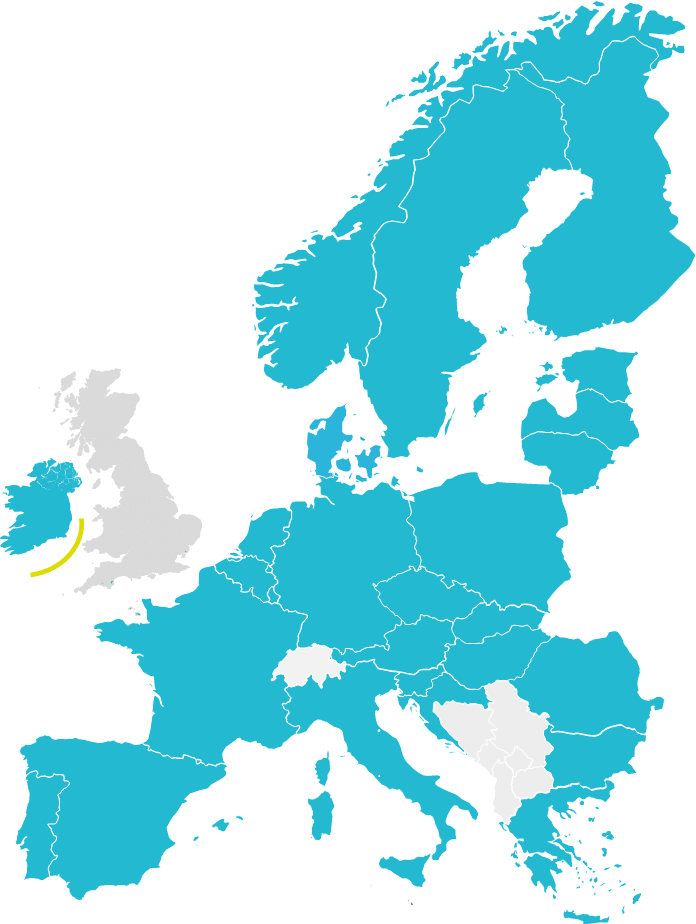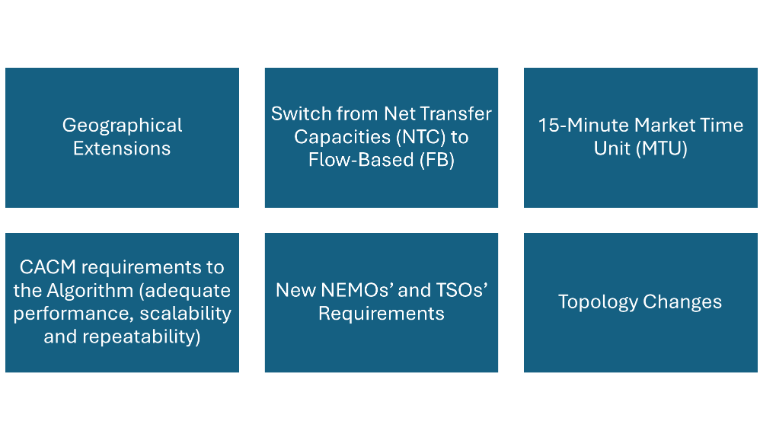
The aim of Single Day-ahead Coupling (SDAC) is to create a single pan European cross zonal day-ahead electricity market. SDAC allocates scarce cross-border transmission capacity in the most efficient way by coupling wholesale electricity markets from different regions through a common algorithm, simultaneously taking into account cross-border transmission constraints thereby maximising social welfare.
An integrated day-ahead market increases the overall efficiency of trading by:

SDAC is an initiative between the Nominated Electricity Market Operators (NEMOs) and Transmission System Operators (TSOs) which – in the framework of the Capacity Allocation and Congestion Management (CACM) implementation – enables cross-border trading across Europe via implicit auctions for delivery of power for the following day.
Significant efforts have been devoted to the establishment of a pan-European Single Day-Ahead Coupling in recent years. This has been possible thanks to early implementation initiatives and pilot projects. SDAC relies on the Price Coupling of Regions (PCR) solution developed by a group of power exchanges. Following an interim phase during which two parallel market couplings co-existed, i.e. the Multi Regional Coupling (MRC) and the 4M Market Coupling (4M MC) on an equal basis jointly forming the Single Day-Ahead Coupling in implementation of CACM, since 17 June 2021 one single coupling is in place.
February: launch of the North-Western Europe (NWE) Price Coupling operating under a common day-ahead power price calculation using the PCR solution. The same solution was also used at the same time in the South - Western Europe (SWE) region in a common synchronized mode. The first go-live of this coupling included the following countries: Belgium, Denmark, Estonia, Finland, France, Germany/Austria, Great Britain, Latvia, Lithuania, Luxembourg, the Netherlands, Norway, Poland (via the SwePol Link), Sweden, Portugal and Spain.
May: full coupling NWE and SWE via Multi Regional Coupling (MRC).
November: the 4M MC went live using the PCR solution. The following countries were part of the 4M MC: Czech Republic, Hungary, Romania and Slovakia.
February: Italy and Slovenia coupled with MRC.
January: Bulgaria joined MRC (isolated mode).
February: Croatia joined MRC (isolated mode).
June: Croatia coupled with MRC.
October: the Single Electricity Market on the island of Ireland coupled with MRC, split of the German-Austrian bidding zone into two separate ones.
December: Greece coupled with SDAC (MRC coupling).
January: EU-GB interconnectors and GB bidding zones exited SDAC (MRC coupling).
May: Bulgaria coupled with SDAC (MRC coupling).
June: The flow-based implicit allocation was implemented in the Core Capacity Calculation Region within the framework of the Core Flow-Based Market Coupling Project which was the target solution required by regulation.
June: With the go-live of the Core flow-based project, the Croatian – Hungarian border was included in the SDAC coupling.
To accomplish SDAC, TSOs and NEMOs worked in close collaboration.
50Hertz Transmission, ADMIE, Amprion, APG, AST, ČEPS, Creos, EirGrid, Elering, ELES, ELIA, Energinet, ESO, Fingrid, HOPS, Litgrid, MAVIR, PSE, REE, REN, RTE, SEPS, SONI, Statnett, Svenska Kraftnät, TenneT DE, TenneT NL, Terna, Transelectrica, and TransnetBW.
BRM, BSP, CROPEX, SEMOpx (EirGrid and SONI), EPEX, EXAA, GME, HEnEx, HUPX, IBEX, Nord Pool, OMIE, OKTE, OPCOM, OTE, and TGE.
Day-ahead market coupling requires processing input from all involved NEMOs and TSOs – essentially bids and offers and network capacities and constraints – matching them by operating one single algorithm, and lastly validating and sending outputs, such as matched trades, clearing prices, and scheduled exchanges, to NEMOs and TSOs. These procedures occur within precise and tight timelines, while ensuring optimal economic solutions, high performance, and robustness.
How Does Single Day-Ahead Coupling Work in Detail?
The SDAC makes use of a common price coupling algorithm, called PCR EUPHEMIA, to calculate electricity prices across Europe and to implicitly allocate auction-based cross-border capacity.
Input data to PCR EUPHEMIA are the network capacities and constraints provided by the TSOs and the bids and offers provided by the NEMOs.
PCR EUPHEMIA matches energy demand and supply for a full 24 - hour period. The algorithm runs a combinatorial optimization process based on (i) the modelling of the matching problem (ii) the implementation of dedicated branch-and-bound strategies and (iii) the utilization of a standard optimization solver. The code of the algorithm uses Java and is interfaced with the matching system via an Oracle database.
This process maximizes social welfare (consumer surplus, supplier surplus and congestion rent) and takes into account price limits of orders and network constraints. The algorithm is designed to regard a large variety of orders and network features as well as local market rules.
Output data are clearing prices, matched trades, scheduled exchanges, and the net position of bidding areas.
Since its launch PCR EUPHEMIA has been continuously developed further. The most recent major development has been the integration of multi-NEMO requirements. With the latest release, smaller changes like shadow prices for maximum import/export allocation constraints and the calculation of aggregated curves have been implemented.
PCR EUPHEMIA aims at full compliance with CACM. Furthermore, PCR EUPHEMIA is used in the context of Single Intraday Coupling for the execution of intraday auctions for the pricing of cross-border capacity (IDAs). Notwithstanding the important achievements of the PCR EUPHEMIA, cycles of Research and Development (R&D) are being executed in order to support further extensions of the market coupling, new market designs and a higher quality of performance, such as:

EUPHEMIA Lab Studies
The R&D program called Euphemia Lab is a joint approach of NEMOs and TSOs with periodic reporting to institutions and stakeholders. The R&D program consists of researching a list of potential solutions to improve the target KPIs. Priority is given to improve implemented CACM requirements . It is to be noted that research on a topic takes at least 6 months and subsequent integration into production takes at least one year.
Press Releases:
2025
2024
2023
2022
Previous press releases
Information Notes:
2025
2024
2023
2022
Previous Information Notes
SDAC Joint Steering Committee Meeting Minutes
Since 2022 the so-called Market Coupling Steering Committee is active, tackling joint topics regarding both SDAC and SIDC. The minutes of it can be found here. Previously SDAC-only Meeting Minutes can be found here:
According to article 20.7 of the Algorithm Methodology as approved by ACER all NEMOs shall in coordination with TSOs publish, by 1 September 2020, and then continuously update the relevant parts of the following documents:
a. operational contracts;
b. operational procedures;
c. change control procedures
d. monitoring procedures;
e. fallback procedures; and
f. back-up procedures.
These documents are published in accordance with article 20.7 of the Algorithm Methodology for transparency purposes. Any consultation or use of these documents is at your own risk and responsibility and the parties to the SDAC cooperation cannot be held liable for any damage incurred as a result of the use of these documents. Furthermore, these documents can only be used or quoted provided prior written consent is obtained of the parties to the SDAC cooperation. No rights or obligations can be derived from these documents. The publication of these documents does not affect any (intellectual) property right pertaining to these documents or to the information contained therein. The publication of these documents does not preclude the rights of the parties to the SDAC cooperation to amend, replace or suppress the documents.
Please note the following:
For reasons of confidentiality certain parts of the content of the documents have been blackened out or have not been published (e.g. Annex 5 of the DAOA).
SDAC Joint Documentation
Day-Ahead Operational Agreement (DAOA) | |
Annex 2: SDAC Operational Procedures – see separate list below | |
Annex 2: SDAC Operational Procedures | |
SDAC_NOR_03 - Market Coupling Results and Scheduled Exchanges Transfer | |
SDAC_NOR_04 - Trading Confirmation and Scheduled Exchanges Notification | |
SDAC_SPE_02 - Impact of price limits in Nordic-Baltic reached |
SDAC NEMO Only Documentation
All NEMO | |
Annex 7: Cost Sharing Monitoring and Settlement Annex 7: Cost Sharing Monitoring and Settlement (2nd Amendment) | |
Annex 8: Standard Power of Attorney for Third Party services | |
NEMO Day-Ahead Procedures

I want to be informed of the latest news by mail: